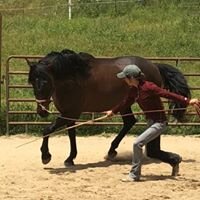Are you Riding the Head and Neck?
The Head and Neck Will Take Care of Itself
Somewhere along the path of their learning journeys, many riders including myself became conditioned to constantly observe and correct the horse’s head and neck position. We were taught that if the horse’s head/neck was in a desirable frame it meant everything about our ride was going well. This led to over-prioritizing the front end of the horse, often at the expense of addressing all the other critical components of a horse’s body mechanics. Without realizing it, we spent the ride fidgeting with the bit above all else.
When I first rode with trainers who thankfully steered me on a different path, they spent a lot of time reminding me to lengthen the reins. Stop playing around with the bit. Just forget for a moment about the head and neck. Huh? Forget about the factor by which we measured our session’s success?? Wasn’t that like copping out from our goal? “The head and neck will take care of itself,” Manolo Mendez used to plead with me, reminding me to focus on everything else. And he was absolutely right every time.
As I have experienced over and over, a horse’s head/neck will adopt the ideal position as I help the horse bend and align his ribcage, travel with steady rhythm and symmetry, and relax emotionally. At first this can seem inexplicable; it’s almost too easy. Without constant fiddling with the reins or encountering resistance, we end up at our goal. In other words, we ride the horse from back to front, as the classical masters taught repeatedly.
A brief consideration of the horse’s muscles explains why the head and neck will take care of themselves. In order for him to stabilize his neck posture, the horse must relax and tone the interconnected muscles in his trunk and along his spine. The neck muscles do not work in isolation. They can support postures only when the groups that attach to them make it possible. For instance, if the trunk muscles are completely slack or hyper-tensioned the neck muscles on the end of that chain cannot perform correct contractions independently.
The more a rider fiddles with the reins the more rigid these muscles become, which makes them unstable. This creates a vicious cycle with the rider tempted to niggle the reins even more to get the head and neck right. The solution is not in the neck; it is in the body. We must fix the body first and the head placement will result automatically.
Trusting this process requires gumption, though, and it can be easier to succumb to the expectations of those watching us. Letting the BODY take care of the HEAD requires letting things get a little messy. The picture will not be one of a horse that is ready for the show ring but one of navigating his imbalances to find a good, sustainable change. Things will look, necessarily, like a work in progress. And that is okay. In fact, it’s better than okay. You might be in this process for 10 minutes, 10 days, or sometimes 10 months. Take a deep breath and relax. You might as well enjoy the process because there is no way around it: the only way to improve a horse’s mechanics is through his whole body not just his neck.



